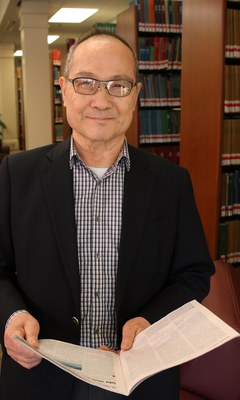Fred Lo
 Kwok-Yung (Fred) Lo, our friend and colleague, passed away on December 16, 2016.
Kwok-Yung (Fred) Lo, our friend and colleague, passed away on December 16, 2016.
Fred was an eminent scientist who led the NRAO as its Director and Distinguished Astronomer from September 2002 to May 2012, an important decade during which the NRAO and its international partners realized the construction and initiation of science operations with the Atacama Large Millimeter/submillimeter Array (ALMA). Fred also led the NRAO while the Expanded Very Large Array (EVLA) project was built and completed - on time, to specification, and under budget - enabling the rebirth of the 1970s-era VLA as the much more capable Karl G. Jansky Very Large Array. During his tenure as Director, the Green Bank Telescope and the Very Long Baseline Array also made extraordinary progress in their scientific capabilities and productivity. Fred's vision and leadership were vital to each of these major NRAO technical and scientific successes.
Born in 1947 in Nanjing, Fred arrived in the United States in 1965 to attend the Massachusetts Institute of Technology, where he earned a B.S. and a Ph.D. in Physics in 1969 and 1974, respectively. He joined the California Institute of Technology in 1974 as a Research Fellow in Radio Astronomy, and in 1976, took up a position at the University of California, Berkeley as a Miller Fellow. Two years later, Fred returned to Caltech where he held research and teaching positions until, in 1986, he became a Professor of Astronomy at the University of Illinois at Urbana-Champaign and served as Astronomy Department Chair from 1995 to 1997. Immediately prior to coming to the NRAO, Fred joined the Academia Sinica in Taipei, Taiwan in 1997 as Director of its newly-formed Institute of Astronomy and Astrophysics, and was appointed Professor of Physics at the National Taiwan University in 1998.
Fred was an accomplished radio astronomer and physicist whose research impacted international scientific progress across multiple fields. His interests ranged from mega-masers to star formation, starbursts, the Galactic Center, and cosmology. Fred made the first millimeter-wave interferometric map of carbon monoxide emission from an external galaxy and in 1986, he and Mark Claussen were the first to suggest that luminous water maser emission in external galaxies is circumnuclear, affiliated with active galactic nuclei, and could serve as very high resolution probes of the centers of galaxies. These keen insights led eventually to the Megamaser Cosmology Project that is now accurately measuring the expansion rate of the Universe and that will yield a direct test of the standard cosmological model and meaningfully constrain the nature of dark energy; Fred was one of the driving forces in the project.
Fred's vision and science-first approach continue to shape radio astronomy and NRAO. His force of character and remarkable intellect made him a notable leader in our profession. Throughout his long life and career he touched many lives, and we miss him.




Connect with NRAO